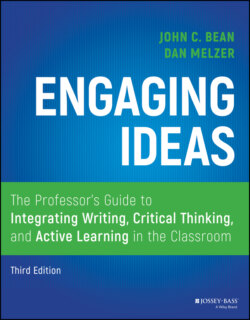Читать книгу Engaging Ideas - John C. Bean - Страница 49
Overview of the Writing Across the Curriculum and Critical Thinking Movements
ОглавлениеBefore we turn to the way that writing promotes critical thinking, let's take a brief look at the overlapping histories of the Writing Across the Curriculum and critical thinking movements. Since its origins in the 1970s, Writing Across the Curriculum has developed into a nationwide (and increasingly a worldwide) network of practitioners and researchers, often loosely organized into programs shaped by local exigencies and culture. (For a history of Writing Across the Curriculum, see Bazerman and others, 2005; Condon and Rutz, 2012; McLeod and Soven, 2006; and Russell, 2002. For further resources, see The WAC Clearinghouse at wac.colostate.edu and the Association for Writing Across the Curriculum at wacassociation.org.) Sometimes a distinction is made between Writing Across the Curriculum (WAC) and Writing in the Disciplines (WID). The former is often associated with “writing to learn,” the aim of which is to use a variety of writing activities to promote deep learning of a course's ideas, concepts, and skills. The latter is more often associated with “learning to write,” particularly with learning to write within the discipline‐specific genres and styles of the student's major. In places where speaking is paired with writing, programs are often designated as Communication Across the Curriculum (CAC). Another increasingly influential approach is known as Writing‐Enriched Curriculum (WEC), pioneered by the University of Minnesota. In this faculty‐directed model, individual departments create “writing plans” for infusing relevant writing, writing instruction, and writing assessment into their undergraduate curricula (see Anson and Flash, forthcoming; Flash, 2016, forthcoming). A related movement emerging in Europe, sponsored by the European Association of Teachers of Academic Writing (EATAW), focuses specifically on academic writing in specialized settings, often targeting graduate students' writing theses. Lately, many institutions have added quantitative literacy to this mix so that students often write papers analyzing quantitative data and using numbers or other empirical data to support claims. What this kaleidoscope of movements has in common is a constructivist view of knowledge that demands from students critical thinking rather than memorization and regurgitation. (For an insightful overview of these movements from the perspective of writing in physics, see Hoehn and Lewandowski, 2020.)
A parallel movement has focused on teaching critical thinking. The literature reveals considerable consensus on how critical thinking can be defined. A widely cited definition comes from Paul and Elder (2009), who characterize critical thinking as follows:
A well‐cultivated critical thinker:
raises vital questions and problems, formulating them clearly and precisely
gathers and assesses relevant information, using abstract ideas to interpret it effectively
comes to well‐reasoned conclusions and solutions, testing them against relevant criteria and standards
thinks open‐mindedly within alternative systems of thought, recognizing and assessing, as need be, their assumptions, implications, and practical consequences; and
communicates effectively with others in figuring out solutions to complex problems. (2)*
In chapter 1, we also summarized the definitions of Brookfield (1987) and Kurfiss (1988). Similarly, Perkins, Jay, and Tishman (1994) argue that critical thinkers question assumptions and seek out alternative perspectives that they analyze open‐mindedly. All of these theorists agree that skilled critical thinkers demand justification of claims, seek to disconfirm hypotheses, avoid hasty conclusions, and provide reasons and evidence for their own claims.
Although experts largely agree on what critical thinking means, they often disagree on how to teach it or to assess it. One approach, which we might characterize as “psychometric,” disaggregates critical thinking into a variety of subskills such as making inferences, recognizing assumptions, and detecting fallacies. Practitioners then design exercises aimed at developing each subskill. Different scholars identify different sets of subskills. For example, Ennis (1996, 2006) has developed a taxonomy categorizing dozens of subskills under the headings of “dispositions” (three kinds) and “abilities” (fifteen kinds), and one researcher, as reported by Fawkes (2001), identifies 250 subskills. (For a comprehensive bibliography of the research literature and critical thinking textbooks arising from this approach, see Ennis, 2006.) Psychometric researchers have developed a variety of machine‐gradable multiple‐choice instruments to assess critical thinking skills. The most widely used of these are the Watson Glaser Critical Thinking Appraisal, the California Critical Thinking Skills Test, the Cornell Critical Thinking Test (Levels X or Z), and the California Critical Thinking Disposition Inventory (see Fawkes, 2001, for information about these tests).
However, this approach to critical thinking doesn't illuminate the relationship of critical thinking to writing—that is, to the generation of ideas and to the production of one's own arguments. Another strand of the critical thinking movement—focused on making arguments—is more helpful. Within this approach, critical thinking is taught and assessed by asking students to construct arguments in response to what cognitive psychologists call “ill‐structured problems”—that is, problems that cannot be solved algorithmically to yield a single right answer. Kurfiss (1988) defines critical thinking as “an investigation whose purpose is to explore a situation, phenomenon, question, or problem to arrive at a hypothesis or conclusion about it that integrates all available information and that can therefore be convincingly justified” (2). According to Kurfiss, an effective assessment of critical thinking would typically ask students to develop a “best solution” to an ill‐structured problem and to justify the proposed solution with appropriate reasons and evidence. This approach has influenced the developers of the Collegiate Learning Assessment (CLA) to design a critical thinking assessment based on writing rather than a multiple‐choice test (see Hersh, 2007).
The rest of this chapter explores in more detail the relationship between writing and critical thinking. It focuses first on the dialogic view of knowledge that underlies academic writing. It then describes students' difficulties in producing thesis‐based organizational structures, explores various theoretical explanations for these difficulties, and suggests pedagogical strategies for overcoming them through improved critical thinking. It concludes with an examination of the writing processes through which experienced writers, in a series of evolving drafts, discover, complicate, and clarify their ideas.
